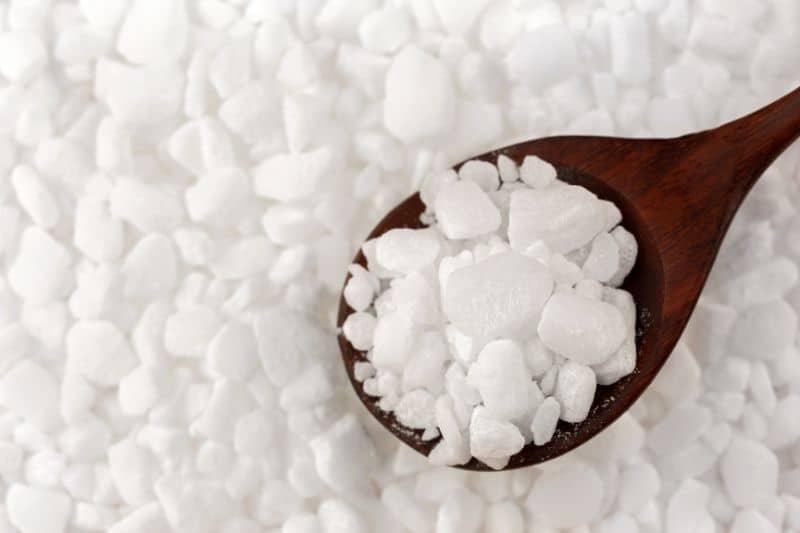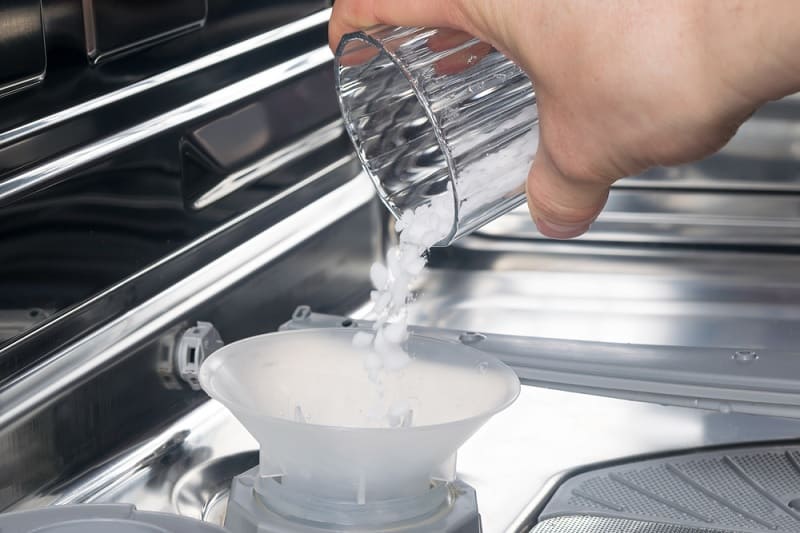You’re probably more used to adding salt to your chips than to your dishwasher, but using dishwasher salt is very important if you live in a hard water area.
Dishwasher salt is different to table salt, but can be cheaply purchased in most supermarkets.
To use dishwasher salt, you just need to locate your dishwasher’s salt reservoir, open the screw cap, funnel in salt until it reaches 1 cm below the lip of the reservoir, then screw the cap back on.
I’ll now cover some more intricacies of using dishwasher salt, including how your first time filling the salt reservoir will differ from the rest, and whether dishwasher salt can be used for other purposes.
How to Fill your Dishwasher’s Salt Reservoir
Fortunately, filling the salt is one of the easiest parts of owning a dishwasher! I’ll break it down into steps here.
1. Locate your dishwasher’s salt reservoir
Most dishwashers will have the water softening unit and salt reservoir on the inside, underneath the bottom rack.
The reservoir will probably be off to one side, most commonly the left side, and will be covered by a screw cap.
2. Remove the bottom rack
Pull out the bottom rack entirely to give you full access to the salt reservoir. You can lift the rack from its rollers if necessary.
3. Unscrew the salt cap

Your salt reservoir will have a screw cap covering it.
To unscrew the cap, follow the directional arrows on top. If there are no arrows, try turning it anti-clockwise (left).
What to do if the salt cap is stuck
The underside of your salt cap may become encrusted with salt over time, making it difficult to unscrew. This problem can be solved by soaking a rag in hot water and laying it on top of the cap until it cools, then trying to unscrew it again.
If your salt cap is regularly being stubborn, try investing in a salt cap spanner like this one that fits Siemens, Bosch, and Neff dishwashers.
The above spanner receives constant customer commendations from people who are now able to unscrew their salt cap without breaking a sweat.
4. Grab a funnel for your salt
Your dishwasher unit should come supplied with a salt funnel to keep the inside of your dishwasher salt-free and help you avoid salt wastage.
If you don’t have a funnel, you can buy a replacement funnel on a site like Amazon or eSpares. Funnels are available for different dishwasher brands.
Check product descriptions for your dishwasher’s brand to see if it’s compatible or measure the diameter of your salt reservoir’s opening and compare it with the funnel’s listed measurements.
For example, this cheap Beko funnel doesn’t fit other dishwasher models perfectly, but it typically does the job!
5. Grab your dishwasher salt

You should only use dishwasher salt with your dishwasher; ordinary table salt won’t provide any benefits, and it may clog your dishwasher.
You can get cheap own-brand dishwasher salt from most supermarkets. I’d recommend purchasing 3 kg of Asda’s own dishwasher salt, which should cost you around £1.60.
Typically, the only brand-name dishwasher salt you can find is Finish, but supermarket own-brand dishwasher salt is cheaper and chemically the same, so I’d forgo the brand name this time.
6. Pour salt into the reservoir
You can slot the funnel into the salt reservoir, but I’d recommend holding your funnel above the reservoir to avoid the neck getting wet. This will keep the salt pouring smoothly.
Pour salt into the funnel, filling the reservoir to around 1cm below the lip. Expect some water to overflow as you do this.
7. Clean up any spilled salt or water
If any salt granules are laying around the unit, wipe them up with a wet cloth. This will stop your dishes and the inside of your dishwasher from being scratched by salt, which is very coarse.
You should also wipe up any spilled water with a dry cloth, though this won’t harm your dishwasher.
8. Firmly screw the salt cap on
No other substances must get into your dishwasher’s water softening unit, so you should ensure that the salt cap is tightly screwed on.
Follow the directional arrows on the cap when turning it or try turning it clockwise (to the right) to tighten it.
9. Replace the lower dish rack
Slot the lower dish rack back onto its rollers, covering up the salt reservoir.
With that, you’re done, and you’re prepared to do it all again once your salt refill indicator lights up!
Adding Salt to a Dishwasher for the First Time
Adding water is the most crucial step when filling your dishwasher’s salt reservoir for the first time – aside from adding the dishwasher salt, of course.
You should follow the guide above, but fill the salt reservoir with water before you funnel in the salt.
After removing your dishwasher’s salt cap, grab a jug with a spout and fill it with cold or lukewarm tap water.
Then, pour water into your dishwasher’s salt reservoir until the water level is 1cm below the brim. This will prevent too much water from overflowing when you add the salt, although some spillage is inevitable.
Can You Eat Dishwasher Salt?
If you’re tempted to grab for the dishwasher salt when you’ve run out of table salt, you should probably nip to the corner shop for more table salt instead.
While dishwasher salt is chemically similar to table salt, it doesn’t undergo the same product testing as table salt since it’s not intended for consumption. This means that dishwasher salt may contain traces of toxins, so you shouldn’t eat it unless you want some time off work.
You also shouldn’t cook with dishwasher salt.
Can You Use Dishwasher Salt for Anything Else?
With 3 kg of table salt in your cupboard, you might wonder if it has other uses.
You can pretty much use dishwasher salt in place of table salt, assuming you’re not consuming it or applying it to your body (due to the possibility of it being contaminated by toxins).
Here are some other possible uses for dishwasher salt:
- Melting ice. Spread some salt on an area to melt snow or ice – it’ll work just like grit. Use a tablespoon of dishwasher salt for each square metre, or more if that’s not cutting it.
- Killing weeds. If weeds are bothering your garden, sprinkle dishwasher salt around the base of each plant, on top of the soil. Then spray some water on the salt to help it dissolve. It should attack the roots of the weed, stopping the plant from gaining nutrients. Repeat this weekly until the weeds are gone.
- Making scented simmering granules. If you’ve got a tealight oil burner, you can replace the oil with salt sizzlers for a burner that’s easier to clean. You can make your own scented granules using dishwasher salt, scented oils, and food colouring – follow these instructions to try it.
- Dyeing clothes. You can use dishwasher salt in a dyebath, but you should dissolve the large granules in water separately before adding them to the bath. I’d recommend just using table salt if you have it, but dishwasher salt will do in a pinch.
Conclusion
Dishwasher salt is a cheap product that can be bought at most supermarkets, and is not to be confused with finer table salt.
It should be added to your dishwasher regularly to keep it running its best.
You can add dishwasher salt to your dishwasher’s salt reservoir to soften the water and keep the inside of your dishwasher free from limescale.
To use dishwasher salt, just remove the cap from your dishwasher’s salt reservoir and pour the salt in with a funnel until it’s around 1cm below the lip. Expect some water to overflow from the reservoir!
If it’s your first time adding salt to your dishwasher, you should first fill the salt reservoir with tap water until it reaches 1 cm under the brim. You won’t ever need to add water again.
Dishwasher salt shouldn’t be eaten or applied to your body, since it may contain trace amounts of toxins.
However, you can use dishwasher salt for many purposes that you’d typically use table salt for, such as melting ice, killing weeds, and dyeing clothes.

A recent uni graduate who likes writing, gaming, and drawing. I’m figuring out housekeeping tips alongside you while trying to provide eco-friendly cleaning options. Let’s find out how to use a tumble dryer together!






